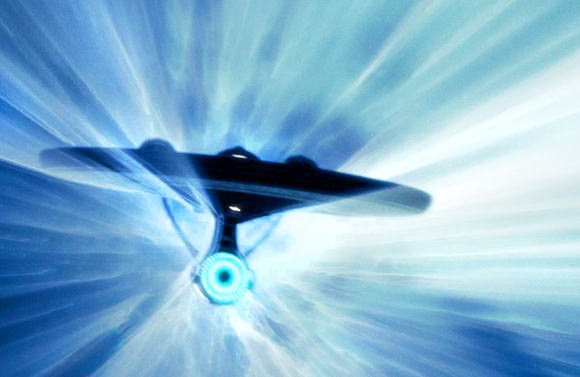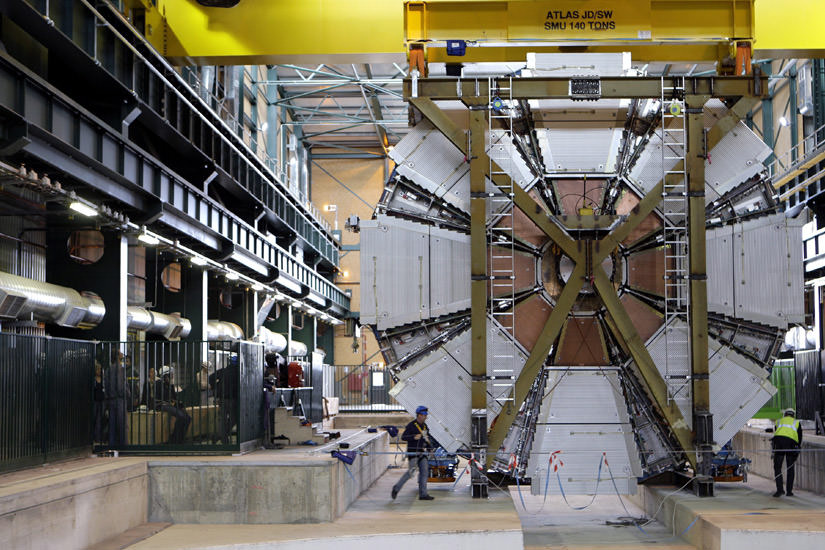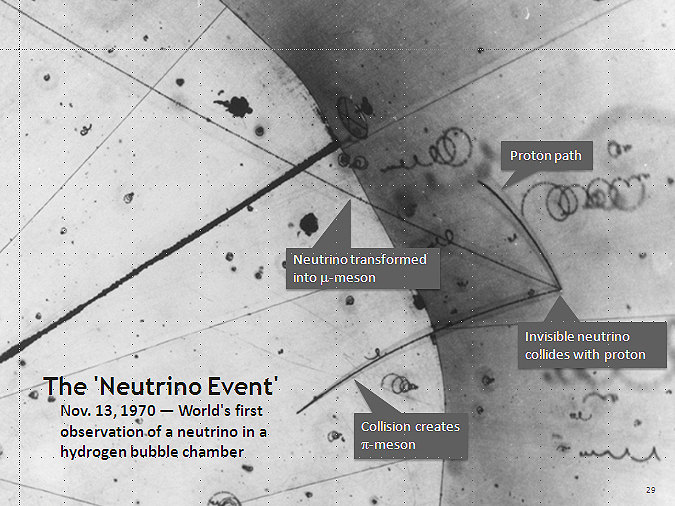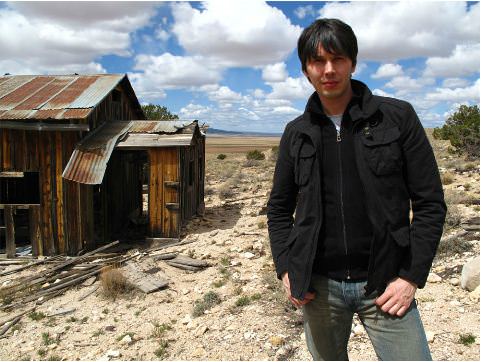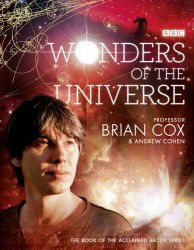Expedition 30 astronaut and chemical engineer Don Pettit continues his ongoing “Science off the Sphere” series with this latest installment, in which he demonstrates some of the peculiar behaviors of thin sheets of water in microgravity. Check it out — you might be surprised how water behaves when freed from the bounds of gravity (and put under the command of a cosmic chemist!)
Warp Drives May Come With a Killer Downside
[/caption]
Planning a little space travel to see some friends on Kepler 22b? Thinking of trying out your newly-installed FTL3000 Alcubierre Warp Drive to get you there in no time? Better not make it a surprise visit — your arrival may end up disintegrating anyone there when you show up.
“Warp” technology and faster-than-light (FTL) space travel has been a staple of science fiction for decades. The distances in space are just so vast and planetary systems — even within a single galaxy — are spaced so far apart, such a concept is needed to make casual human exploration feasible (and fit within the comforts of people’s imagination as well… nobody wants to think about Kirk and Spock bravely going to some alien planet while everyone they’ve ever known dies of old age!)
While many factors involving FTL travel are purely theoretical — and may remain in the realm of imagination for a very long time, if not ever — there are some concepts that play well with currently-accepted physics.
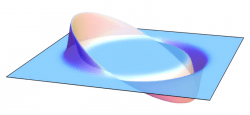
The Alcubierre warp drive is one of those concepts.
Proposed by Mexican theoretical physicist Miguel Alcubierre in 1994, the drive would propel a ship at superluminal speeds by creating a bubble of negative energy around it, expanding space (and time) behind the ship while compressing space in front of it. In much the same way that a surfer rides a wave, the bubble of space containing the ship and its passengers would be pushed at velocities not limited to the speed of light toward a destination.
Of course, when the ship reaches its destination it has to stop. And that’s when all hell breaks loose.
Researchers from the University of Sydney have done some advanced crunching of numbers regarding the effects of FTL space travel via Alcubierre drive, taking into consideration the many types of cosmic particles that would be encountered along the way. Space is not just an empty void between point A and point B… rather, it’s full of particles that have mass (as well as some that do not.) What the research team — led by Brendan McMonigal, Geraint Lewis, and Philip O’Byrne — has found is that these particles can get “swept up” into the warp bubble and focused into regions before and behind the ship, as well as within the warp bubble itself.
When the Alcubierre-driven ship decelerates from superluminal speed, the particles its bubble has gathered are released in energetic outbursts. In the case of forward-facing particles the outburst can be very energetic — enough to destroy anyone at the destination directly in front of the ship.
“Any people at the destination,” the team’s paper concludes, “would be gamma ray and high energy particle blasted into oblivion due to the extreme blueshifts for [forward] region particles.”
In other words, don’t expect much of a welcome party.
Another thing the team found is that the amount of energy released is dependent on the length of the superluminal journey, but there is potentially no limit on its intensity.
“Interestingly, the energy burst released upon arriving at the destination does not have an upper limit,” McMonigal told Universe Today in an email. “You can just keep on traveling for longer and longer distances to increase the energy that will be released as much as you like, one of the odd effects of General Relativity. Unfortunately, even for very short journeys the energy released is so large that you would completely obliterate anything in front of you.”
So how to avoid disintegrating your port of call? It may be as simple as just aiming your vessel a bit off to the side… or, it may not. The research only focused on the planar space in front of and behind the warp bubble; deadly postwarp particle beams could end up blown in all directions!
Luckily for Vulcans, Tatooinians and any acquaintances on Kepler 22b, the Alcubierre warp drive is still very much theoretical. While the mechanics work with Einstein’s General Theory of Relativity, the creation of negative energy densities is an as-of-yet unknown technology — and may be impossible.
Which could be a very good thing for us, should someone out there be planning a surprise visit our way!
Read more about Alcubierre warp drives here, and you can download the full University of Sydney team’s research paper here.
Thanks to Brendan McMonigal and Geraint Lewis for the extra information!
Main image © Paramount Pictures and CBS Studios. All rights reserved.
Faster Than Light? More Like Faulty Wiring.
[/caption]
You can shelf your designs for a warp drive engine (for now) and put the DeLorean back in the garage; it turns out neutrinos may not have broken any cosmic speed limits after all.
Ever since the news came out on September 22 of last year that a team of researchers in Italy had clocked neutrinos traveling faster than the speed of light, the physics world has been resounding with the potential implications of such a discovery — that is, if it were true. The speed of light has been a key component of the standard model of physics for over a century, an Einstein-established limit that particles (even tricky neutrinos) weren’t supposed to be able to break, not even a little.
Now, according to a breaking news article by Edwin Cartlidge on AAAS’ ScienceInsider, the neutrinos may be cleared of any speed violations.
“According to sources familiar with the experiment, the 60 nanoseconds discrepancy appears to come from a bad connection between a fiber optic cable that connects to the GPS receiver used to correct the timing of the neutrinos’ flight and an electronic card in a computer,” Cartlidge reported.
The original OPERA (Oscillation Project with Emulsion-tRacking Apparatus) experiment had a beam of neutrinos fired from CERN in Geneva, Switzerland, aimed at an underground detector array located 730 km away at the Gran Sasso facility, near L’Aquila, Italy. Researchers were surprised to discover the neutrinos arriving earlier than expected, by a difference of 60 nanoseconds. This would have meant the neutrinos had traveled faster than light speed to get there.
Repeated experiments at the facility revealed the same results. When the news was released, the findings seemed to be solid — from a methodological standpoint, anyway.
Shocked at their own results, the OPERA researchers were more than happy to have colleagues check their results, and welcomed other facilities to attempt the same experiment.
Repeated attempts may no longer be needed.
Once the aforementioned fiber optic cable was readjusted, it was found that the speed of data traveling through it matched the 60 nanosecond discrepancy initially attributed to the neutrinos. This could very well explain the subatomic particles’ apparent speed burst.
Case closed? Well… it is science, after all.
“New data,” Cartlidge added, “will be needed to confirm this hypothesis.”
See the original OPERA team paper here.
_______________________
UPDATE 2/22/12 11:48 pm EST: According to a more recent article on Nature’s newsblog, the Science Insider report erroneously attributed the 60 nanosecond discrepancy to loose fiber optic wiring from the GPS unit, based on inside “sources”. OPERA’s statement doesn’t specify as such, “saying instead that its two possible sources of error point in opposite directions and it is still working things out.”
OPERA’s official statement released today is as follows:
“The OPERA Collaboration, by continuing its campaign of verifications on the neutrino velocity measurement, has identified two issues that could significantly affect the reported result. The first one is linked to the oscillator used to produce the events time-stamps in between the GPS synchronizations. The second point is related to the connection of the optical fiber bringing the external GPS signal to the OPERA master clock.
These two issues can modify the neutrino time of flight in opposite directions. While continuing our investigations, in order to unambiguously quantify the effect on the observed result, the Collaboration is looking forward to performing a new measurement of the neutrino velocity as soon as a new bunched beam will be available in 2012. An extensive report on the above mentioned verifications and results will be shortly made available to the scientific committees and agencies.” (via Nature newsblog.)
Dancing Water Drops In Earth Orbit
An astronaut once told me that fellow space flier Don Pettit could fix anything with a paper clip. Indeed, Pettit has nicknames like Mr. Wizard and Mr. Fixit, and he is well-known for his Saturday Morning Science videos during his first stay on the International Space Station and his “Zero G Coffee Cup” from a space shuttle mission he was on in 2008. Now in his second long-duration stint on the ISS, Pettit has a new video series called “Science off the Sphere” and the first video is above. Pettit uses “knittin” needles (watch the video to hear Pettit’s pronunciation) and water droplets to demonstrate physics in space, and shows what fun astronauts can have with water in zero-G with his ‘dancing’ water droplets.
This new video series is partnership between NASA and the American Physical Society. But there’s more than just videos, as at the end of each video Pettit poses a challenge question. Submit your answers at the Science Off the Sphere website for a chance to have your name read from space and receive a snazzy t-shirt from Earth.
Here’s this week’s Challenge Question:
Continue reading “Dancing Water Drops In Earth Orbit”
Guest Post: The Cosmic Energy Inventory
[/caption]
Now that the old year has drawn to a close, it’s traditional to take stock. And why not think big and take stock of everything there is?
Let’s base our inventory on energy. And as Einstein taught us that energy and mass are equivalent, that means automatically taking stock of all the mass that’s in the universe, as well – including all the different forms of matter we might be interested in.
Of course, since the universe might well be infinite in size, we can’t simply add up all the energy. What we’ll do instead is look at fractions: How much of the energy in the universe is in the form of planets? How much is in the form of stars? How much is plasma, or dark matter, or dark energy?
The chart above is a fairly detailed inventory of our universe. The numbers I’ve used are from the article The Cosmic Energy Inventory by Masataka Fukugita and Jim Peebles, published in 2004 in the Astrophysical Journal (vol. 616, p. 643ff.). The chart style is borrowed from Randall Munroe’s Radiation Dose Chart over at xkcd.
These fractions will have changed a lot over time, of course. Around 13.7 billion years ago, in the Big Bang phase, there would have been no stars at all. And the number of, say, neutron stars or stellar black holes will have grown continuously as more and more massive stars have ended their lives, producing these kinds of stellar remnants. For this chart, following Fukugita and Peebles, we’ll look at the present era. What is the current distribution of energy in the universe? Unsurprisingly, the values given in that article come with different uncertainties – after all, the authors are extrapolating to a pretty grand scale! The details can be found in Fukugita & Peebles’ article; for us, their most important conclusion is that the observational data and their theoretical bases are now indeed firm enough for an approximate, but differentiated and consistent picture of the cosmic inventory to emerge.
Let’s start with what’s closest to our own home. How much of the energy (equivalently, mass) is in the form of planets? As it turns out: not a lot. Based on extrapolations from what data we have about exoplanets (that is, planets orbiting stars other than the sun), just one part-per-million (1 ppm) of all energy is in the form of planets; in scientific notation: 10-6. Let’s take “1 ppm” as the basic unit for our first chart, and represent it by a small light-green square. (Fractions of 1 ppm will be represented by partially filled such squares.) Here is the first box (of three), listing planets and other contributions of about the same order of magnitude:
So what else is in that box? Other forms of condensed matter, mainly cosmic dust, account for 2.5 ppm, according to rough extrapolations based on observations within our home galaxy, the Milky Way. Among other things, this is the raw material for future planets!
For the next contribution, a jump in scale. To the best of our knowledge, pretty much every galaxy contains a supermassive black hole (SMBH) in its central region. Masses for these SMBHs vary between a hundred thousand times the mass of our Sun and several billion solar masses. Matter falling into such a black hole (and getting caught up, intermittently, in super-hot accretion disks swirling around the SMBHs) is responsible for some of the brightest phenomena in the universe: active galaxies, including ultra high-powered quasars. The contribution of matter caught up in SMBHs to our energy inventory is rather modest, though: about 4 ppm; possibly a bit more.
Who else is playing in the same league? The sum total of all electromagnetic radiation produced by stars and by active galaxies (to name the two most important sources) over the course of the last billions of years, to name one: 2 ppm. Also, neutrinos produced during supernova explosions (at the end of the life of massive stars), or in the formation of white dwarfs (remnants of lower-mass stars like our Sun), or simply as part of the ordinary fusion processes that power ordinary stars: 3.2 ppm all in all.
Then, there’s binding energy: If two components are bound together, you will need to invest energy in order to separate them. That’s why binding energy is negative – it’s an energy deficit you will need to overcome to pry the system’s components apart. Nuclear binding energy, from stars fusing together light elements to form heavier ones, accounts for -6.3 ppm in the present universe – and the total gravitational binding energy accumulated as stars, galaxies, galaxy clusters, other gravitationally bound objects and the large-scale structure of the universe have formed over the past 14 or so billion years, for an even larger -13.4 ppm. All in all, the negative contributions from binding energy more than cancel out all the positive contributions by planets, radiation, neutrinos etc. we’ve listed so far.
Which brings us to the next level. In order to visualize larger contributions, we need a change scale. In box 2, one square will represent a fraction of 1/20,000 or 0.00005. Put differently: Fifty of the little squares in the first box correspond to a single square in the second box:
So here, without further ado, is box 2 (including, in the upper right corner, a scale model of the first box):
Now we are in the realm of stars and related objects. By measuring the luminosity of galaxies, and using standard relations between the masses and luminosity of stars (“mass-to-light-ratio”), you can get a first estimate for the total mass (equivalently: energy) contained in stars. You’ll also need to use the empirical relation (“initial mass function”) for how this mass is distributed, though: How many massive stars should there be? How many lower-mass stars? Since different stars have different lifetimes (live massively, die young), this gives estimates for how many stars out there are still in the prime of life (“main sequence stars”) and how many have already died, leaving white dwarfs (from low-mass stars), neutron stars (from more massive stars) or stellar black holes (from even more massive stars) behind. The mass distribution also provides you with an estimate of how much mass there is in substellar objects such as brown dwarfs – objects which never had sufficient mass to make it to stardom in the first place.
Let’s start small with the neutron stars at 0.00005 (1 square, at our current scale) and the stellar black holes (0.00007). Interestingly, those are outweighed by brown dwarfs which, individually, have much less mass, but of which there are, apparently, really a lot (0.00014; this is typical of stellar mass distribution – lots of low-mass stars, much fewer massive ones.) Next come white dwarfs as the remnants of lower-mass stars like our Sun (0.00036). And then, much more than all the remnants or substellar objects combined, ordinary, main sequence stars like our Sun and its higher-mass and (mostly) lower-mass brethren (0.00205).
Interestingly enough, in this box, stars and related objects contribute about as much mass (or energy) as more undifferentiated types of matter: molecular gas (mostly hydrogen molecules, at 0.00016), hydrogen and helium atoms (HI and HeI, 0.00062) and, most notably, the plasma that fills the void between galaxies in large clusters (0.0018) add up to a whopping 0.00258. Stars, brown dwarfs and remnants add up to 0.00267.
Further contributions with about the same order of magnitude are survivors from our universe’s most distant past: The cosmic background radiation (CMB), remnant of the extremely hot radiation interacting with equally hot plasma in the big bang phase, contributes 0.00005; the lesser-known cosmic neutrino background, another remnant of that early equilibrium, contributes a remarkable 0.0013. The binding energy from the first primordial fusion events (formation of light elements within those famous “first three minutes”) gives another contribution in this range: -0.00008.
While, in the previous box, the matter we love, know and need was not dominant, it at least made a dent. This changes when we move on to box 3. In this box, one square corresponds to 0.005. In other words: 100 squares from box 2 add up to a single square in box 3:
Box 3 is the last box of our chart. Again, a scale model of box 2 is added for comparison: All that’s in box 2 corresponds to one-square-and-a-bit in box 3.
The first new contribution: warm intergalactic plasma. Its presence is deduced from the overall amount of ordinary matter (which follows from measurements of the cosmic background radiation, combined with data from surveys and measurements of the abundances of light elements) as compared with the ordinary matter that has actually been detected (as plasma, stars, e.g.). From models of large-scale structure formation, it follows that this missing matter should come in the shape (non-shape?) of a diffuse plasma, which isn’t dense (or hot) enough to allow for direct detection. This cosmic filler substance amounts to 0.04, or 85% of ordinary matter, showing just how much of a fringe phenomena those astronomical objects we usually hear and read about really are.
The final two (dominant) contributions come as no surprise for anyone keeping up with basic cosmology: dark matter at 23% is, according to simulations, the backbone of cosmic large-scale structure, with ordinary matter no more than icing on the cake. Last but not least, there’s dark energy with its contribution of 72%, responsible both for the cosmos’ accelerated expansion and for the 2011 physics Nobel Prize.
Minority inhabitants of a part-per-million type of object made of non-standard cosmic matter – that’s us. But at the same time, we are a species, that, its cosmic fringe position notwithstanding, has made remarkable strides in unravelling the big picture – including the cosmic inventory represented in this chart.
__________________________________________
Here is the full chart for you to download: the PNG version (1200×900 px, 233 kB) or the lovingly hand-crafted SVG version (29 kB).
The chart “The Cosmic Energy Inventory” is licensed under Creative Commons BY-NC-SA 3.0. In short: You’re free to use it non-commercially; you must add the proper credit line “Markus Pössel [www.haus-der-astronomie.de]”; if you adapt the work, the result must be available under this or a similar license.
Technical notes: As is common in astrophysics, Fukugita and Peebles give densities as fractions of the so-called critical density; in the usual cosmological models, that density, evaluated at any given time (in this case: the present), is critical for determining the geometry of the universe. Using very precise measurements of the cosmic background radiation, we know that the average density of the universe is indistinguishable from the critical density. For simplicity’s sake, I’m skipping this detour in the main text and quoting all of F & P’s numbers as “fractions of the universe’s total energy (density)”.
For the supermassive black hole contributions, I’ve neglected the fraction ?n in F & P’s article; that’s why I’m quoting a lower limit only. The real number could theoretically be twice the quoted value; it’s apparently more likely to be close to the value given here, though. For my gravitational binding energy, I’ve added F & P’s primeval gravitational binding energy (no. 4 in their list) and their binding energy from dissipative gravitational settling (no. 5).
The fact that the content of box 3 adds up not quite to 1, but to 0.997, is an artefact of rounding not quite consistently when going from box 2 to box 3. I wanted to keep the sum of all that’s in box 2 at the precision level of that box.
Slower than Light Neutrinos
[/caption]
Earlier this year, an international team of scientists announced they had found neutrinos — tiny particles with an equally tiny but non-zero mass — traveling faster than the speed of light. Unable to find a flaw themselves, the team put out a call for physicists worldwide to check their experiment. One physicist who answered the call was Dr. Ramanath Cowsik. He found a potentially fatal flaw in the experiment that challenged the existence of faster than light neutrinos.
Superluminal (faster than light) neutrinos were the result of the OPERA experiment, a collaboration between the CERN physics laboratory in Geneva, Switzerland, and the Laboratori Nazionali del Gran Sasso in Gran Sasso, Italy.
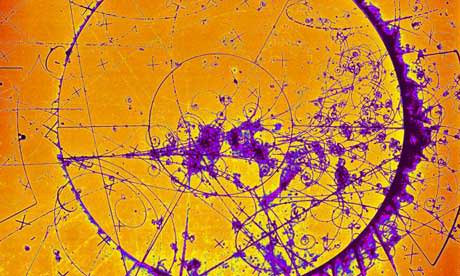
The experiment timed neutrinos as they traveled 730 kilometres (about 450 miles) through Earth from their origin point at CERN to a detector in Gran Sasso. The team was shocked to find that the neutrinos arrived at Gran Sasso 60 nanoseconds sooner than they would have if they were traveling at the speed of light in a vacuum. In short, they appeared to be superluminal.
This result created either a problem for physics or a breakthrough. According to Einstein’s theory of special relativity, any particle with mass can come close to the speed of light but can’t reach it. Since neutrinos have mass, superluminal neutrinos shouldn’t exist. But, somehow, they did.
But Cowsik questioned the neutrinos’ genesis. The OPERA experiments generated neutrinos by slamming protons into a stationary target. This produced a pulse of pions, unstable particles that were magnetically focused into a tunnel where they decayed into neutrinos and muons (another tiny elementary particle). The muons never went further than the tunnel, but the neutrinos, which can slip through matter like a ghost passes through a wall, kept going towards Gran Sasso.
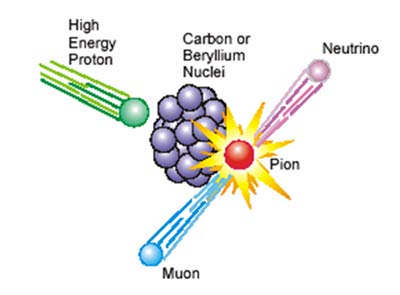
Cowsik’s and his team looked closely at this first step of the OPERA experiment. They investigated whether “pion decays would produce superluminal neutrinos, assuming energy and momentum are conserved,” he said. The OPERA neutrinos had a lot of energy but very little mass, so the question was whether they could really move faster than light.
What Cowsik and his team found was that if neutrinos produced from a pion decay were traveling faster than light, the pion lifetime would get longer and each neutrino would carry a smaller fraction of the energy it shares with the muon. Within the present framework of physics, superluminal neutrinos would be very difficult to produce. “What’s more,”Cowsik explains, “these difficulties would only increase as the pion energy increases.
There is an experimental check of Cowsik’s theoretical conclusion. CERN’s method of producing neutrinos is duplicated naturally when cosmic rays hit Earth’s atmosphere. An observatory called IceCube is set up to observe these naturally occurring neutrinos in Antarctica; as neutrinos collide with other particles, they generate muons that leave trails of light flashes as they pass through a nearly 2.5 kilometre (1.5 mile) thick block of clear ice.
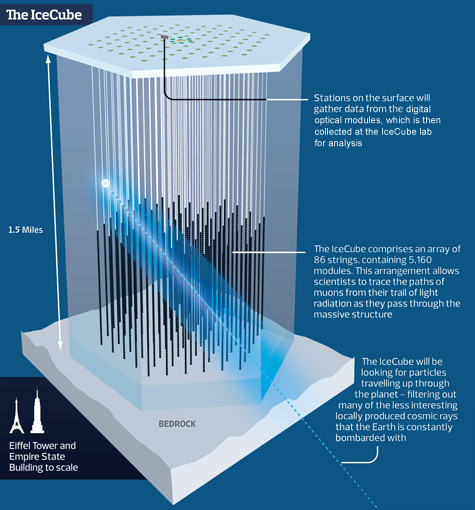
IceCube has detected neutrinos with energy 10,000 times higher than any generated as part of the OPERA experiment, leading Cowsik to conclude that their parent pions must have correspondingly high energy levels. His team’s calculations based on laws of the conservation of energy and momentum revealed that the lifetimes of those pions should be too long for them to decay into superluminal neutrinos.
As Cowsik explains, IceCube’s detection of high-energy neutrinos is indicative that pions do decay according to standard ideas of physics, but the neutrinos will only approach the speed of light; they will never exceed it.
Source: Pions Don’t Want to Decay into Faster the Light Neutrinos
TV Viewing Alert: New Mini-Series: Fabric of the Cosmos
A new 4-part mini-series debuts tonight on PBS station in the US, featuring theoretical physicist Brian Greene. The series is called “Fabric of the Cosmos” and is based on Greene’s 2004 book of the same name. It premieres tonight (Nov. 2, 2011) on NOVA, with subsequent episodes airing November 9, 16 and 23. The series will probe the most extreme realms of the cosmos, from black holes to dark matter, to time bending and parallel realities.
Check your local listings for time.
Particle Physics and Faster-Than-Light Neutrinos…Discuss.
On September 22, an international team of researchers working on the OPERA project at the Gran Sasso research facility released a paper on some potentially physics-shattering findings: beams of neutrinos that had traveled from the CERN facility near Geneva to their detector array outside of Rome at a speed faster than light. (Read more about this here and here.) Not a great deal faster, to be sure – only 60 nanoseconds faster than expected – but still faster. There’s been a lot of recoil from the scientific community about this announcement, and rightly so, since if it does end up being a legitimate finding then it would force us to rework much of what we have come to know about physics ever since Einstein’s theory of relativity.
Of course, to those of us not so well-versed in particle physics *raises hand* a lot of this information can quickly become overwhelming, to say the least. Thankfully the folks at Sixty Symbols have recorded this interview with two astrophysicists at the UK’s University of Nottingham. It helps explain some of the finer points of the discovery, what it means and what the science community in general thinks about it. Check it out!
Thanks to Dan Satterfield for posting this at his Wild Wild Science blog.
Breaking the Speed of Light

[/caption]
It’s been a tenet of the standard model of physics for over a century. The speed of light is a unwavering and unbreakable barrier, at least by any form of matter and energy we know of. Nothing in our Universe can travel faster than 299,792 km/s (186,282 miles per second), not even – as the term implies – light itself. It’s the universal constant, the “c” in Einstein’s E = mc2, a cosmic speed limit that can’t be broken.
That is, until now.
An international team of scientists at the Gran Sasso research facility outside of Rome announced today that they have clocked neutrinos traveling faster than the speed of light. The neutrinos, subatomic particles with very little mass, were contained within beams emitted from CERN 730 km (500 miles) away in Switzerland. Over a period of three years, 15,000 neutrino beams were fired from CERN at special detectors located deep underground at Gran Sasso. Where light would have made the trip in 2.4 thousandths of a second, the neutrinos made it there 60 nanoseconds faster – that’s 60 billionths of a second – a tiny difference to us but a huge difference to particle physicists!
The implications of such a discovery are staggering, as it would effectively undermine Einstein’s theory of relativity and force a rewrite of the Standard Model of physics.

“We are shocked,” said project spokesman and University of Bern physicist Antonio Ereditato.
“We have high confidence in our results. We have checked and rechecked for anything that could have distorted our measurements but we found nothing. We now want colleagues to check them independently.”
Neutrinos are created naturally from the decay of radioactive materials and from reactions that occur inside stars. Neutrinos are constantly zipping through space and can pass through solid material easily with little discernible effect… as you’ve been reading this billions of neutrinos have already passed through you!
The experiment, called OPERA (Oscillation Project with Emulsion-tRacking Apparatus) is located in Italy’s Gran Sasso facility 1,400 meters (4,593 feet) underground and uses a complex array of electronics and photographic plates to detect the particle beams. Its subterranean location helps prevent experiment contamination from other sources of radiation, such as cosmic rays. Over 750 scientists from 22 countries around the world work there.
Ereditato is confident in the results as they have been consistently measured in over 16,000 events over the past two years. Still, other experiments are being planned elsewhere in an attempt to confirm these remarkable findings. If they are confirmed, we may be looking at a literal breakdown of the modern rules of physics as we know them!
“We have high confidence in our results,” said Ereditato. “We have checked and rechecked for anything that could have distorted our measurements but we found nothing. We now want colleagues to check them independently.”
A preprint of the OPERA results will be posted on the physics website ArXiv.org.
Read more on the Nature article here and on Reuters.com.
UPDATE: The OPERA team paper can be found here.
Q&A with Brian Cox, part 3: ‘Wonders’ and Popularizing Science
[/caption]
Professor Brian Cox is the Chair in Particle Physics at the University of Manchester, and works on the ATLAS experiment (A Toroidal LHC ApparatuS) at the Large Hadron Collider at CERN. But he’s also active in the popularization of science, specifically with his new television series and companion book, Wonders of the Universe. Universe Today had the chance to talk with Cox, and on Tuesday he told us about the recent advances in particle physics, and on Wednesday we asked him about his favorite space missions and his hopes for the future of science. Today, Cox tells us about his role in sharing science with the public, and talks about his new book and filming the television series.
For a chance to win a copy of the “Wonders of the Universe” book, see our contest post.
Universe Today: You’ve been really busy, with writing books, filming two television series and DVDs. Do you have time to do research in particle physics as well?
Brian Cox: Well, I must say I’ve been a bit restricted over the past couple of years in how much research I’ve done. I’m still attached to the experiment at CERN, but it’s just one of those things! In many ways it’s a regret because I would love to be there full time at the moment because it is so genuinely exciting. We’re making serious progress and we’re going to discover something like the Higgs particle, I would guess, within the next 12 months.
But then again, you can’t do everything and it’s a common regret amongst academics, actually, that that as they get older, they get taken away from the cutting-edge of research if they’re not careful! But I suppose it is not a bad way to be taken away from the cutting edge, to make TV programs and push this agenda that I have to make science more relevant and popular.
UT : Absolutely! Outreach and educating the public is very important, especially in the area of research you are in. I would guess a majority of the general public are not exceptionally well-versed in particle physics.
Cox: Well, Carl Sagan is a great hero of mine and he used to say it is really about teaching people the scientific method – or actually providing the understanding and appreciation of what science is. We look at these questions, such as what happened just after the Universe began, or why the particles in the Universe have mass – they are very esoteric questions.
But the fact that we’ve been able build some reasonable theories about the how old universe is — and we have a number 13.73 ± 0.12 billion years old, quite a precise number — so the question of showing how you get to those quite remarkable conclusions is very important. When you look at what we might call more socially-important subjects – for example how to respond to global warming, or what should be our policy for vaccinating the population against disease, or how should we produce energy in the future, and if you understand what the scientific method is and that it is apolitical and a-religious and it is a-everything and there is no agenda there, and is just pure way of looking of universe, that’s the important thing for society to understand.
UT : Please tell us about your new book, “Wonders of the Universe.”
“Wonders of the Universe” is a book about the television series. Traditionally these books are quite ‘coffee table,’ image-heavy books. The filming of the series took longer than we anticipated, so actually the book got written relatively quickly because I had time to sit down and really just write about the physics. Although it is tied with the television series, it does go quite a lot deeper in many areas. I’m quite pleased about that. So it’s more than just snapshots of my view of the physics of the TV series.
I should say also, some parts of it are in the form of a diary of what it was like filming the TV series. There are always some things you do and places you go that have quite an impact on you. And I tend to take a lot of pictures so many of the photographs in the book are mine. So, it is written on two levels: It is a much deeper view of the physics of the television series, but secondly it is a diary of the experience of filming the series and going to those places.
(Editor’s note, Cox is also just finishing a book on quantum mechanics, so look for that in the near future)
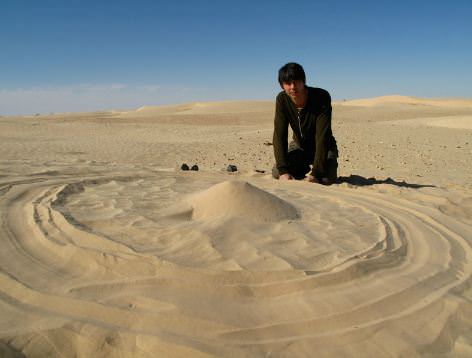
UT : What were some of your best experiences while filming ‘Wonders?’
Cox: One thing that, well, I wouldn’t say enjoyed filming, because it was quite nerve-wracking – but something that really worked was the prison demolition sequence in Rio. We used it as an analog for a collapsing star, a star at the end of its life that has run out of fuel and it collapses under its own gravity. It does that in a matter of seconds, on the same timescale as a building collapses when you detonate it.
Wandering around a building that is full of live dynamite and explosives is not very relaxing! It was all wired up and ready to go. But when we blew it up, and I thought it really worked well, and I enjoyed it a lot, actually as a television piece.
The ambition of the series is to try and get away from using too many graphics, if possible. You obviously have to use some graphics because we are talking about quite esoteric concepts, but we tried to put these things ‘on Earth’, by using real physical things to talk about the processes. What we did, we went inwards into the prison and at each layer we said, here’s where the hydrogen fuses to helium, and here’s the shell where helium goes to carbon and oxygen, and another shell all the way down to iron at the center of the stars. That’s the way stars are built, so we used this layered prison to illustrate that and then collapse it. That’s a good example of what the ambition of the series was.
UT : You’ve been called a rock star in the physics and astronomy field but in actuality you did play in a rock band before returning to science. What prompted that shift in your career?
Cox: I always wanted to be a physicist or astronomer from as far back as I can remember, that was always my thing when I was growing up. I got distracted when I was in my teens, or interested I should say, in music and being in a band. The opportunity came to join a band that was formed by an ex-member of Thin Lizard, a big rock band in the UK, and the States as well, so I did that. We made two albums; we toured with lots of people. That band split up and I went to university and then joined another band as a side line, and that band got successful as well. That was two accidents, really! It was a temporary detour rather than a switch, because I always wanted to do physics.
UT : Thanks for taking the time to talk with us on Universe Today – we appreciate all the work you do in making science more accessible so everyone can better appreciate and understand how it impacts our lives.
Cox: Thank you, I appreciate it!
Find out more about Brian Cox at his website, Apollo’s Children

